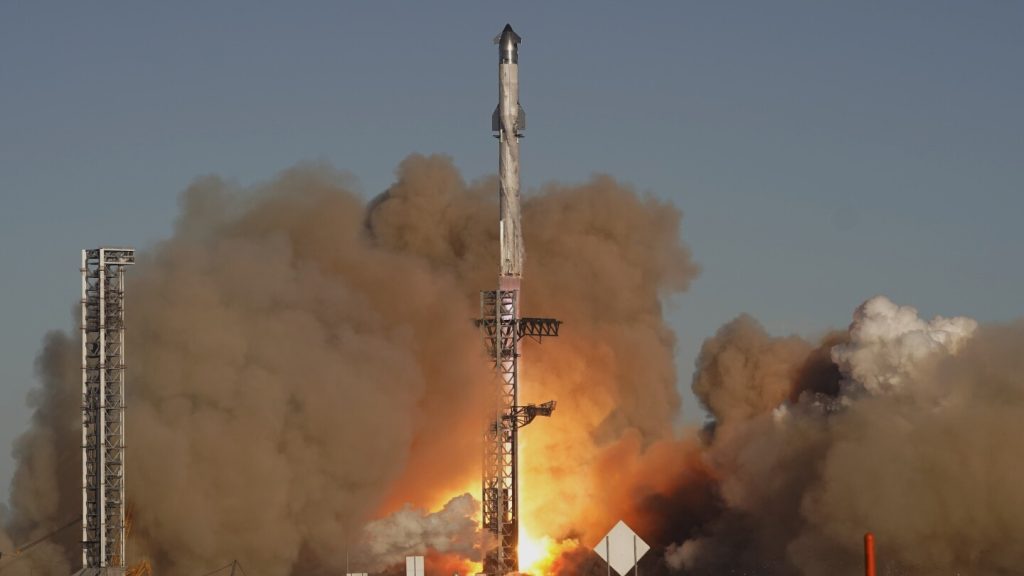SpaceX’s Starship Test Flight Ends in Fiery Disintegration: A Setback on the Path to Mars
SpaceX’s ambitious Starship program, aimed at revolutionizing space travel and enabling human missions to Mars, experienced a significant setback during its latest test flight. The Starship, a colossal rocket touted as the world’s largest and most powerful, met an untimely demise shortly after liftoff, breaking apart and scattering flaming debris across the sky near the Caribbean. Initial assessments by SpaceX suggest a fire, possibly ignited by leaking fuel accumulating above the engine firewall, was the primary culprit behind the catastrophic failure.
The ill-fated flight, which took place from SpaceX’s launch site in Boca Chica, Texas, began with promise. The Super Heavy booster stage successfully separated and returned to the launchpad for a controlled landing attempt, marking only the second time this maneuver had been achieved in Starship’s testing history. However, as the spacecraft continued its ascent, a series of engine shutdowns unfolded, ultimately leading to the loss of communication and the disintegration of the vehicle approximately 8.5 minutes into the flight. Dramatic footage captured near the Turks and Caicos Islands vividly depicted the spacecraft’s fiery descent, with debris raining down in a spectacle of fireballs, prompting the diversion of nearby air traffic.
While the loss of Starship represents a significant setback for SpaceX, the company emphasizes that the debris fell within the designated launch corridor over the Gulf of Mexico and the Atlantic Ocean, minimizing any potential threat to populated areas. The spacecraft, which was intended to perform a controlled re-entry over the Indian Ocean, carried a payload of ten dummy satellites designed to simulate the deployment of SpaceX’s Starlink internet satellites. This aspect of the mission, aimed at refining the deployment process, was also lost due to the premature termination of the flight.
The incident, though disappointing, is viewed by SpaceX CEO Elon Musk as a "barely a bump in the road" in the overarching pursuit of establishing a fleet of Starships capable of transporting humans to Mars. This unwavering commitment to the Mars colonization vision underscores the iterative nature of space exploration, where setbacks and lessons learned are integral to progress. The accident also highlights the inherent risks and complexities associated with spaceflight, reinforcing the necessity for rigorous testing and continuous improvement.
The seventh test flight of Starship featured a new and upgraded spacecraft design, further emphasizing the experimental nature of the program. Despite the setback, SpaceX maintains a rapid development cycle, with the booster and spacecraft for the eighth demo flight already under construction and undergoing testing. This resilience underscores the company’s commitment to pushing the boundaries of space technology and persevering in the face of challenges.
The Starship program also holds significant implications for NASA’s Artemis program, which aims to return astronauts to the Moon later this decade. SpaceX has secured contracts to provide Starship vehicles for lunar landing missions, further demonstrating the vital role this technology plays in the future of space exploration. NASA Administrator Bill Nelson acknowledged the inherent risks of spaceflight, emphasizing the importance of such tests in advancing our understanding and capabilities. The incident serves as a stark reminder of the challenges involved in pushing the boundaries of space travel and the crucial role of testing in mitigating risks and ensuring future mission success.
The concurrent test flight of Blue Origin’s New Glenn rocket, while achieving orbit, also experienced a setback with the loss of the booster stage during its landing attempt. This highlights the complex and challenging environment of space exploration, where even seemingly successful missions can encounter unforeseen complications. The incidents involving both SpaceX’s Starship and Blue Origin’s New Glenn underscore the inherent risks and complexities associated with pushing the boundaries of space travel. Both companies remain committed to advancing space technology and view these setbacks as learning opportunities in the pursuit of their ambitious goals. The ongoing development and testing of these innovative launch systems are essential steps towards realizing humanity’s aspirations for deeper exploration and utilization of space.

